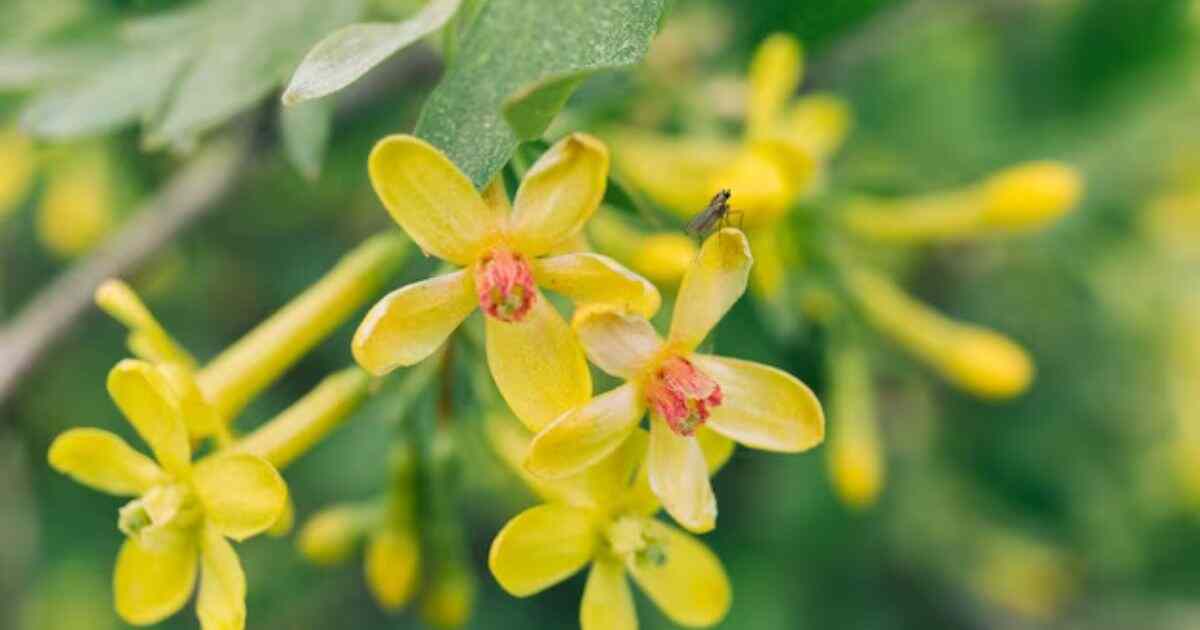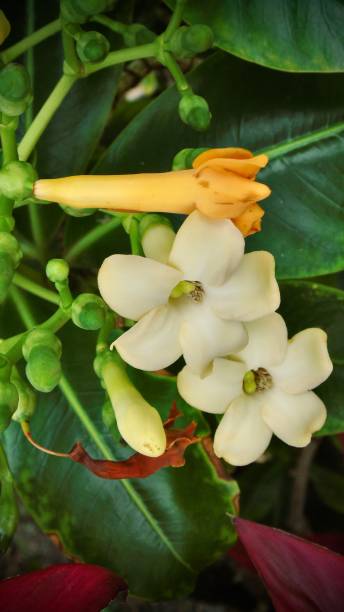Puakenikeni flower name, Fagraea berteriana, a shrub or grand flowering tree with sturdy stems and sweet-scented blossoms, hails from New Guinea and northern Australia, spreading widely across the South Pacific.
Revered for its perfect build, it gained fame as the dime flower (pua meaning flower, kenikeni meaning dime or ten cents). Today we are going to talk about nature’s beautiful Puakenikeni flower meaning, its name, significant characteristics, and much more.
Now let’s explore the Puakenikeni plant in detail.

What is the Puakenikeni Flower?
The air layering pua keni keni, sometimes called perfume flower tree, grows as either a big bush or a little tree that spreads out. People in the Samoan Islands call it pua-lulu, while in Tonga and Tahiti, they just say pua.
Pua kenikeni is native to Northern Australia and the Caroline Islands extending to the Marquesas, and thrives on high islands across this region. It populates various habitats, from lowland to montane forests, often gracing lowland lava flows in Samoa, narrow ridges in Rarotonga, and montane and cloud forests.
In some regions, cultivation prevails, notably in Tonga, potentially its native habitat, and Hawai’i, where it has been recently introduced. The tree, typically a shrub but capable of attaining a height of 15 m (50 ft), is valued for its aromatic white flowers, serving as a garden ornament and a source of timber.
Puakenikeni flower Name
The puakenikeni flower is famous with several other names. Puakenikeni scientific name if Fagraea berteroana. The other names are perfume flower, pua kenikeni, pua lulu, pua and Anthirrhoea puakenikeni. It is a rare flower native to Hawaii.
Botanical Characteristics of Puakenikeni Flower lei
- The Puakenikeni english name is Fagraca berteroana A. Gray ex Benth, belonging to the Gentianaceae family (formerly Loganiaceae), specifically the Potalicae subfamily.
- They are also known as ksid in Palau, mbua in Fiji, peengas in Chuuk, and pua in various Pacific regions, including Tonga, Horne Islands, ‘Uvea, Niue, Cooks, Tahiti, Australs, Rapa, Marquesas, and Hawai’i.
- They are typically reaching up to 15 meters in height, though often shorter, especially in open environments and as a strangler. The trunk tends to be many-branched at the base, featuring a spreading crown.
- The flowers form a terminal, many-flowered cyme, usually with 9-25 flowers, branched at the base.
- The calyx is urn-shaped, 9-16 mm long, with 5 ovate sepals.
- The trumpet-shaped corolla is white, aging to yellow or pale orange, with a tube measuring 4-11 cm long.
- The stem is divided into 5 oblong, contorted lobes, each 1.7-3.6 cm long. Flowering can occur throughout the year, sometimes continuously.
- Leaves are simple, opposite, and fleshy, mostly elliptic to obovate, ranging from 8-22 cm in length.
- They are acute to cuneate at the bottom and shortly narrow at the tip.
- The surface is smooth, with indistinct veins, and the upper side is darker.
- Margins are entire, with a petiole measuring 1.5-5 cm long.
- Its stipules form a fleshy, notched structure (ocrea) in the leaf axil.

How To Grow Puakenikeni Flower
- From the very beginning, this plant starts slow, often taking a few years to reach a height of 1 m (3.3 ft).
- On the other side, plants grown from air layers or cuttings show quicker growth.
- The speed of growth is interesting; a rooted cutting of 0.5 m (1.5 ft) may hit 2 m (6.6 ft) in 3-5 years under good conditions, displaying its life vividly.
- Flowering and fruiting happen throughout the year, with occasional highs. Samoa, for example, experiences a peak in flowering from May to September.
- Plants propagated vegetatively usually start flowering a few months after being planted.
- Yields are promising, as the tree, though at times irregular, generously produces many flowers.
- The plant easily reproduces through seeds, but seedlings may take 5-7 years to bloom.
- Air-layering, a common technique, yields flowering plants within 9 months under perfect conditions.
- Air-layering, preferably on 1-2 years old branches, involves girdling and removing a bark ring 2-4 cm (0.8-1.6 in) wide. Hormone treatment with IBA (indole butyric acid) helps in root formation.
- A moist rooting medium like sphagnum moss is packed and wrapped with impermeable material.
- After 6-8 weeks, check for roots, and upon sufficient growth, carefully separate and transplant into a pot.
- The planting varies but is typically 45 cm (18 in) tall and 1-2 cm (0.4-0.8 in) in diameter at the base.
- Successful air-layering, followed by container growth, ensures a 100% survival rate. Pua kenikeni can flourish in a minimum 5-gallon container.

Advantages and disadvantages of Puakenikeni Flower
1. The Advantages of Puakinekini Flower include:-
- The blooms of the Puakenikeni flower emit a sweet scent, perfect for preparing scented coconut oil. You can adorn yourself with flower leis or tuck them behind your ear for a fragrant touch.
- A rapidly growing shrub thrives in well-drained soil, serving as an ideal wall or privacy screen.
- You can indulge in Puakenikeni fragrance oil for a soothing bath salt experience.:
- You can transform Puakenikeni hydrosol into a versatile face toner, hair mist, and body spray.
- You can elevate your mood, reduce stress, and open your heart chakra.
- It reveals the heart, heightens senses, soothes nerves, exudes reverence, boosts energy, and maintains balance.
- It is esteemed for vibrant blossoms and prized timber, and the tree carries cultural importance.
- It is cherished in Polynesia, Melanesia, and Micronesia, its flowers bring scented coconut oil, commercially sold in Hawai’i, Tonga, and beyond.
- Pua kenikeni is robust, finely-grained wood, though often twisted, that shines in tool handles, tools, house posts, and modern crafts.
- It is historically valued in Tahiti for furniture, drums, and canoe parts, it may lack potential as a plantation timber tree.
- Medicinally, Fijian inner bark helps with asthma and diabetes.
- The Tongan bark infusion tackles internal injuries, and in New Caledonia, boiled leaves assist in treating rashes.
- The tree, with its lovely and fragrant blooms, contributes to leis and scented oil, securing a place as an excellent fragrance source.
- The timber caters to diverse needs, from house posts to fuelwood, tools, and crafts.
2. The disadvantages of the Puakenikeni flower include:-
- The air layering Puakenikeni flower has been cultivated for a long in Hawai’i, yet not reported as invasive. It is unlikely to pose a threat beyond its native habitat.
- Common diseases include leaf spots, fungal root rots, and root-knot nematode. Mealybugs, scales, and thrips are frequent pests.
- For optimal flower production, pruning is necessary to encourage new growth and maintain a low tree height for easy harvest.
- Due to its need for full sun, companion species must not exceed the ideal picking height.
- Puakenikeni flower drawbacks include toxicity – its seeds and fruit flesh are harmful, necessitating hand washing post-handling.
- Pests like mealybugs, scales, and thrips pose issues. Beware of ethylene gas; storing near ripe fruits or wilting flowers speeds up aging.
- Refrigeration leads to black, mushy blooms. Older specimens thrive at 15°C, demanding ample watering to prevent root ball dryness.
- Diseases like leaf spot, fungal root rots, and root-knot nematodes are common. Puakenikeni adapts to various soils: calcareous, fresh lava, and weathered clay.

Uses of Puakenikeni Flower
The Puakenikeni flower tree, scientifically known as Fagraea berteroana, serve various purposes:
Leis
Puakenikeni flower is used to create leis for common use, with single flowers adorning ears. The name “pua kenikeni” originates from Hawaiian, combining “pua” (flower) and “kenikeni” (10 cents or a dime).
Uses across nations
Puakenikeni, sacred in various cultures, holds a special place in Tahitian lore, where Tane, the forest god, brought the first pua tree from the tenth heaven. In Mangaian, the pua tree guarded the door to the spirit realm in the underworld. At Kauai Farmacy, they honor the Puakenikeni tree with gratitude, marveling at the daily gift of fragrant flowers.
Scented oil
The use of Puakenikeni flower extends to soaking the flowers in coconut oil producing a fragrant oil for both hair and body.
Fragrance tree
This tree is greatly valued for its aroma and is frequently planted as an ornamental shrub.
Wood
This flower is valued for its fine grain, the wood finds applications in house posts, tool handles, and various small wooden articles, contributing to handicrafts.
Traditional cultural and medicinal uses of Puakenikeni Flower
The Puakenikeni flower is also for embracing tradition, the flowers play a role in cultural and medicinal practices. Ornamental use extends to body adornment and garlands because of its attractive and aromatic flowers. Ceremonially, the tree holds sacred status in the Cook Islands and Tahiti, influencing spiritual paths and divine connections.
Conclusion
To sum it up, the Puakinekini flower is like a beautiful wonder in the world of plants. Its glowing colors and detailed flowers make people cherish it. It’s a plant that can fit in many places, like gardens all around the world. People love it not just for how it looks but also because it’s important in different cultures. Taking Puakenikeni tree care is important, but the joy it brings is much more than the work you put into it. Puakinekini is a lovely addition to any garden, making the outdoors a more delightful place.
Relate article:


